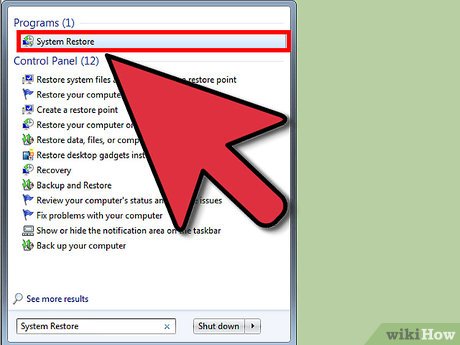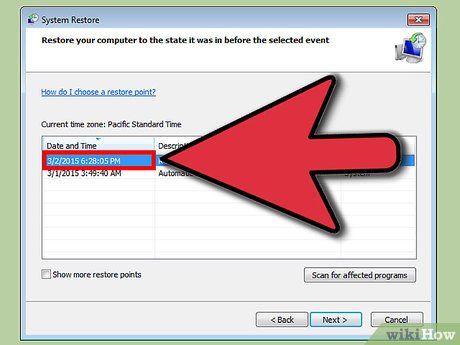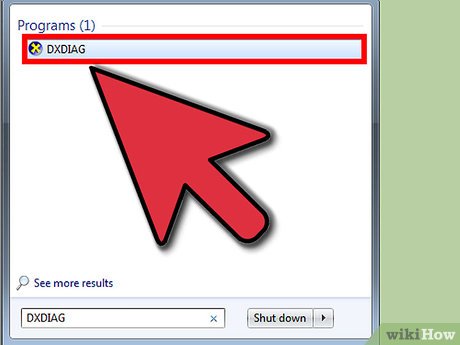How to Uninstall Directx
Method 1 of 2:
Performing a System Restore
-
 Open the System Restore tool. Performing a System Restore is the easiest way to uninstall a DirectX update, since there is no official way to uninstall DirectX. You will need to have a restore point from before DirectX is installed, which is typically created during the installation process. Using System Restore will uninstall and revert ANY changes that were made since the restore point was created, so it should be used very soon after installing the DirectX update.
Open the System Restore tool. Performing a System Restore is the easiest way to uninstall a DirectX update, since there is no official way to uninstall DirectX. You will need to have a restore point from before DirectX is installed, which is typically created during the installation process. Using System Restore will uninstall and revert ANY changes that were made since the restore point was created, so it should be used very soon after installing the DirectX update.- Windows 8 – Open the Start screen and type 'recovery'. Select 'Recovery' from the list of search results. This will open the Recovery window. From there, click the 'Open System Restore' link.
- Windows 7 and Vista – Click Start and type 'restore' into the Search box. Select 'System Restore' from the top of the search results list.
- Windows XP – Click Start and then select All Programs → Accessories → System Tools. Click on System Restore.
-
 Select your restore point. You will be presented with a list of available restore points. Compare dates to find one that was created before DirectX was updated. Click the 'Scan for affected programs' to ensure that DirectX will be rolled back.
Select your restore point. You will be presented with a list of available restore points. Compare dates to find one that was created before DirectX was updated. Click the 'Scan for affected programs' to ensure that DirectX will be rolled back.- Remember, anything that was installed or updated between the point and now will be removed. Any programs that were installed then but are gone now will be reinstalled.
-
 Perform the restore. Once you've chosen your restore point, wait for the restore to be completed. The restore process can take a significant amount of time. The computer will restart during the restore process, and then Windows will load with a message confirming that the restore was successful.
Perform the restore. Once you've chosen your restore point, wait for the restore to be completed. The restore process can take a significant amount of time. The computer will restart during the restore process, and then Windows will load with a message confirming that the restore was successful. -
 Check that DirectX was rolled back. Once Windows starts again, open the Run window by pressing Windows key + R, type in 'dxdiag', and press Enter. This will open the DXDiag tool, which will check your system and report the version of DirectX that is installed.
Check that DirectX was rolled back. Once Windows starts again, open the Run window by pressing Windows key + R, type in 'dxdiag', and press Enter. This will open the DXDiag tool, which will check your system and report the version of DirectX that is installed.- The DirectX version will be listed at the bottom of the System Information section on the first tab.
- You must have some version of DirectX installed with Windows. Windows 7 and later cannot have anything less than DirectX 11 installed.[1]
Method 2 of 2:
Repairing Your Current DirectX Files
-
 Run the DirectX Diagnostic Tool. Open the Run dialog by pressing Windows key + R and enter 'dxdiag'. This will open the DirectX Diagnostic Tool. It will display an overview of your system. You can click each tab to see information on your display, sound, and inputs. A text box at the bottom of each tab will tell you if there are issues detected with that particular system.
Run the DirectX Diagnostic Tool. Open the Run dialog by pressing Windows key + R and enter 'dxdiag'. This will open the DirectX Diagnostic Tool. It will display an overview of your system. You can click each tab to see information on your display, sound, and inputs. A text box at the bottom of each tab will tell you if there are issues detected with that particular system. -
 Download the DirectX installer from Microsoft (but not the file shown in the video above, that is a powerpoint presentation). If you're having difficulties running programs and are receiving DirectX errors, you may have corrupt or missing DirectX files. The best way to try to fix this is by reinstalling the latest version of DirectX. The installer is available for free from Microsoft.
Download the DirectX installer from Microsoft (but not the file shown in the video above, that is a powerpoint presentation). If you're having difficulties running programs and are receiving DirectX errors, you may have corrupt or missing DirectX files. The best way to try to fix this is by reinstalling the latest version of DirectX. The installer is available for free from Microsoft.- If you are having issues, upgrading to the latest version may help much more than uninstalling.
-
 Run the installer. The installer will scan your system and then install the necessary files to update your copy of DirectX to the latest version. Restart your computer after it's finished and check to see if you receive the same errors.
Run the installer. The installer will scan your system and then install the necessary files to update your copy of DirectX to the latest version. Restart your computer after it's finished and check to see if you receive the same errors. -
 Update your video card's driver. Many times, updating your video card drivers will help fix DirectX errors for games and other video-centric programs. To update your driver, you'll need to determine which video card you have, and then download the appropriate file from the manufacturer.
Update your video card's driver. Many times, updating your video card drivers will help fix DirectX errors for games and other video-centric programs. To update your driver, you'll need to determine which video card you have, and then download the appropriate file from the manufacturer.- To find your video card information, open the Run dialog (Windows key + R) and enter 'dxdiag'. Click the Display tab, and note the Chip Type and Manufacturer from the Device section.
- Visit that manufacturer's website. This will typically be NVidia or AMD. Search for your Chip Type on the website and download the latest driver files.
- Run the driver installer. Your old video card files will be overwritten with the latest version. You may notice your screen flickering during the installation process.
-
 Reinstall Windows. If nothing you do seems to be fixing your problem, it may be time to reinstall Windows. This will replace all of your DirectX files with the built-in files with your Windows installation. Reinstalling Windows will take an hour or so, not counting the time it takes to backup and restore your files and reinstall your programs. Follow one of the following guides for your version of Windows:
Reinstall Windows. If nothing you do seems to be fixing your problem, it may be time to reinstall Windows. This will replace all of your DirectX files with the built-in files with your Windows installation. Reinstalling Windows will take an hour or so, not counting the time it takes to backup and restore your files and reinstall your programs. Follow one of the following guides for your version of Windows:- Install Windows 7.
- Install Windows 8.
- Install Windows XP.
- Install Windows Vista.
3.5 ★ | 2 Vote
You should read it
- What is DirectX 12? How important?
- What is the difference between DirectX 11 and DirectX 12?
- How to download Direct X and install DirectX on your computer
- How to check what version of DirectX you are using
- 11 ways to open System Restore on Windows 11
- How to Update DirectX
- How to Install DirectX
- How to fix the DirectX failed to initialize error on Windows 10
May be interested
- How to Update DirectX
 microsoft directx is a set of application programming interfaces (apis) that provide windows programs and apps with the support needed to power video games and game programming on most microsoft platforms. directx is normally updated...
microsoft directx is a set of application programming interfaces (apis) that provide windows programs and apps with the support needed to power video games and game programming on most microsoft platforms. directx is normally updated... - Microsoft launched DirectX 12 game programming interface
 microsoft has officially announced the directx 12 game programming interface at the game developers conference event, which has just taken place in the us.
microsoft has officially announced the directx 12 game programming interface at the game developers conference event, which has just taken place in the us. - How to fix the DirectX failed to initialize error on Windows 10
 sometimes you will get the directx failed to initialize error when installing software like virtual dj on windows 10. in this article, tipsmake will introduce you solutions that can help you fix the above problem.
sometimes you will get the directx failed to initialize error when installing software like virtual dj on windows 10. in this article, tipsmake will introduce you solutions that can help you fix the above problem. - How to Update DirectX Settings
 microsoft directx is a set of application programming interfaces (api) required for running the multimedia features on windows. it is most commonly used with gaming and video applications. there is no way to access or make changes to...
microsoft directx is a set of application programming interfaces (api) required for running the multimedia features on windows. it is most commonly used with gaming and video applications. there is no way to access or make changes to... - How to Install DirectX
 microsoft directx is a bundled set of application programming interfaces (api) required for running many of the multimedia features in the windows operating system. users of windows vista and windows 7 can quickly and easily update their...
microsoft directx is a bundled set of application programming interfaces (api) required for running many of the multimedia features in the windows operating system. users of windows vista and windows 7 can quickly and easily update their... - How to Check Direct X Version
 directx is microsoft's name for a family of application programming interfaces designed to speak to multimedia programs, such as music and video players. the directx family includes direct3d, directmusic and directplay and the 'x' stands...
directx is microsoft's name for a family of application programming interfaces designed to speak to multimedia programs, such as music and video players. the directx family includes direct3d, directmusic and directplay and the 'x' stands... - How to install new version of DirectX on computer
 install the latest version of directx to improve graphics performance and play games more smoothly. free download will guide you through the detailed steps.
install the latest version of directx to improve graphics performance and play games more smoothly. free download will guide you through the detailed steps. - How to fix the error of not being able to install DirectX Win 10?
 are you looking for a solution to fix the error of not being able to install directx win 10? immediately refer to tipsmake's detailed instructions in the article.
are you looking for a solution to fix the error of not being able to install directx win 10? immediately refer to tipsmake's detailed instructions in the article. - Laptops that support DirectX 11 were first sold
 mesh computers has just released the product, which it claims is the first commercially available mesh edge dx laptop to support directx 11 (dx11) processing.
mesh computers has just released the product, which it claims is the first commercially available mesh edge dx laptop to support directx 11 (dx11) processing. - How to uninstall LinkiDoo
 are you looking for an effective solution to completely uninstall linkidoo and thoroughly delete all its files from your pc? do not worry! this article will provide detailed instructions on how to completely uninstall linkidoo.
are you looking for an effective solution to completely uninstall linkidoo and thoroughly delete all its files from your pc? do not worry! this article will provide detailed instructions on how to completely uninstall linkidoo.















 How to Recover BitLocker
How to Recover BitLocker How to Open Terminal in Windows
How to Open Terminal in Windows How to Install Windows Using a CD
How to Install Windows Using a CD How to Use MEGA Sync Client on Windows
How to Use MEGA Sync Client on Windows How to Disable the Capslock Key in Windows
How to Disable the Capslock Key in Windows How to Create and Apply a Custom Mouse Cursor Using a Photo in Windows
How to Create and Apply a Custom Mouse Cursor Using a Photo in Windows